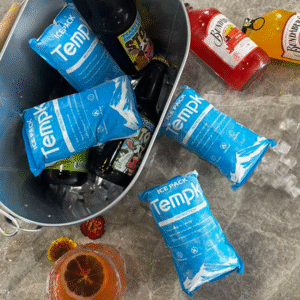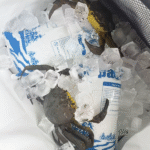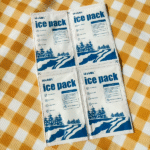Safe Handling of Dry Ice Packs: Best Practices for Cold Chain Logistics
Dry ice is indispensable in cold chain logistics, ensuring the safe transport of temperature-sensitive products. However, mishandling of dry ice can lead to severe consequences, including asphyxiation and frostbite. This guide provides essential safety measures for handling dry ice, ensuring both compliance with 2025 regulations and the protection of personnel and products.

What Are the Safety Risks Associated with Dry Ice Packs in Cold Chain Logistics?
Dry ice sublimates directly into carbon dioxide (CO₂), which is heavier than oxygen and can displace oxygen in confined spaces. This leads to a suffocation risk if not properly ventilated. Handling dry ice improperly can also result in frostbite and physical injuries. Understanding these risks is the first step in ensuring safety.
Safety Risks of Improper Dry Ice Handling
-
Suffocation Risk: CO₂ buildup in poorly ventilated spaces can cause suffocation. This is the most immediate and dangerous risk associated with dry ice handling.
-
Frostbite: Due to its extremely cold temperature of -78.5°C (-109.3°F), dry ice can cause severe cold burns upon direct skin contact.
-
Physical Injury: Improper handling or dropping of dry ice can result in injuries, both to workers and valuable goods.
How Can You Safely Handle and Store Dry Ice Packs?
Safe handling of dry ice begins with understanding its properties and taking the right precautions. By using appropriate protective equipment and ensuring proper storage, the risks associated with dry ice can be minimized.
Best Practices for Dry Ice Handling and Storage
-
Wear Proper Personal Protective Equipment (PPE): Always use insulated gloves, goggles, and long-sleeved clothing to avoid direct contact with dry ice.
-
Ensure Adequate Ventilation: Store and transport dry ice in well-ventilated areas to allow CO₂ gas to escape safely.
-
Use Insulated Containers: Dry ice should be stored in insulated, vented containers that allow for the release of gas while maintaining the cooling effect.
Recommended Storage Options
| Storage Method | Insulation Type | Duration | Safety Impact |
|---|---|---|---|
| Standard Insulated Bin | High | Short-term | Safe, with proper ventilation |
| Dry Ice Freezer | Very High | Long-term | Ideal for extended storage, prevents pressure buildup |
What Equipment Is Essential for Safely Transporting Dry Ice?
Transporting dry ice requires specialized equipment to ensure that the CO₂ gas is safely vented and that the temperature is controlled throughout the journey. Insulated containers and temperature monitoring devices are essential to ensure safe transport.
Essential Tools for Safe Dry Ice Transportation
-
Insulated Containers: Containers should have CO₂ venting capabilities and be clearly labeled with safety warnings.
-
Temperature Monitoring Devices: These devices help track internal temperatures and ensure that the dry ice remains effective.
-
Protective Gear: Insulated gloves and goggles are necessary to prevent accidents when handling dry ice.
How Does Proper Handling Improve Cold Chain Efficiency?
Proper handling directly impacts cold chain efficiency by ensuring that products remain at the required temperature throughout the logistics process. This is especially critical for pharmaceuticals, vaccines, and perishable foods, where temperature control is crucial.
Key Benefits of Safe Dry Ice Handling
-
Improved Product Quality: Consistent temperature control reduces spoilage and ensures products remain viable.
-
Reduced Waste: By maintaining the correct temperature, the risk of spoilage is minimized.
-
Operational Efficiency: Streamlining processes by avoiding unnecessary resupplies and minimizing delays.
What Environmental Considerations Should Be Kept in Mind?
The environmental impact of dry ice is an important consideration. Dry ice is produced from CO₂, and while using CO₂ captured from industrial processes can help reduce the carbon footprint, optimizing its use is still necessary.
Environmental Best Practices
-
Use Dry Ice Made from Captured CO₂: This reduces the carbon emissions associated with dry ice production.
-
Implement Reusable Containers: Using containers that can be reused reduces waste associated with dry ice packaging.
-
Recycle Packaging Materials: Ensure that packaging is recycled to minimize environmental impact.
2025 Trends in Dry Ice Handling and Cold Chain Logistics
As logistics practices evolve, several trends are reshaping the way dry ice is used in cold chain systems. The focus is on sustainability, efficiency, and improving the accuracy of temperature control.
Latest Developments in Dry Ice Technology
-
IoT-Based Temperature Tracking: Real-time monitoring of shipments ensures that temperatures stay within the required range and helps prevent spoilage.
-
Eco-Friendly Dry Ice Production: CO₂ is increasingly being captured from renewable sources, further reducing the environmental footprint of dry ice.
-
Automated Cold Chain Systems: Automated systems that use AI to optimize dry ice usage are improving operational efficiency and safety.
Common Questions About Safe Dry Ice Pack Handling
Q1: How can I prevent CO₂ buildup when storing dry ice?
To prevent CO₂ buildup, always store dry ice in containers that allow gas to vent, and ensure the storage area is well-ventilated.
Q2: Is it safe to ship food with dry ice?
Yes, dry ice can safely ship food as long as proper ventilation and handling precautions are followed. Use vented containers and handle dry ice with protective gloves.
Conclusion
Safe handling of dry ice packs is essential in ensuring both worker safety and product integrity. By following best practices for storage, transportation, and environmental considerations, you can optimize your cold chain logistics operations. Proper training and the use of the right equipment will help prevent accidents and ensure compliance with regulations.
Next Steps
-
Implement Safe Handling Practices: Start by training your team on the latest safety protocols and investing in the right equipment.
-
Ensure Compliance: Follow the regulatory guidelines for shipping dry ice, including proper labeling and documentation.
-
Explore New Technologies: Consider incorporating real-time temperature tracking and automated systems to improve efficiency and minimize risks.
About Tempk
Tempk is a leader in providing advanced cold chain solutions, specializing in dry ice handling equipment and logistics strategies. We offer eco-friendly solutions to optimize your cold chain operations, ensuring the safety, efficiency, and sustainability of your shipments.
Contact Us
For expert advice on improving your cold chain logistics, contact Tempk today. Let us help you ensure the safety of your products and staff while minimizing environmental impact.























